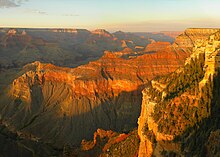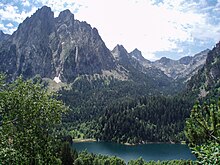Geomorphology
Geomorphology is a branch of geography and geology whose objective is the study of the forms of the earth's surface focused on describing them, understanding their genesis and their current behavior.
Due to its field of study, geomorphology has links with other sciences. One of the most popular geomorphological models explains that the forms of the earth's surface are the result of a dynamic balance —which evolves over time— between constructive and destructive processes, a dynamic known generically as the geographic cycle.
Geomorphology focuses on the study of landforms, but given that these are the result of lithospheric dynamics that generally integrates, as inputs, knowledge from other branches of physical geography, such as climatology, hydrography, pedology, glaciology, and also other sciences, to cover the incidence of biological phenomena, geological and anthropic, in relief. Geomorphology is a science related to both human geography (because of natural hazards and man's relationship with the environment) and mathematical geography (because of topography).
Overview
The Earth's surface is modified by a combination of surface processes that shape landscapes and geologic processes that cause tectonic uplift and subsidence, and shape coastal geography. Surface processes comprise the action of water, wind, ice, fire, and life on the Earth's surface, along with the chemical reactions that form soils and alter material properties, stability, and the rate of change of topography under the force of gravity, and other factors, such as (in the very recent past) human alteration of the landscape. Many of these factors are strongly mediated by climate. Geological processes include the uplift of mountain ranges, the growth of volcanoes, isostatic changes in the elevation of the Earth's surface (sometimes in response to surface processes), and the formation of deep sedimentary basins where the Earth's surface dips and fills. with eroded material from other parts of the landscape. The Earth's surface and its topography, therefore, are an intersection of climatic, hydrological, and biological factors, action with geological processes, or said alternatively, the intersection of the Earth's lithosphere with its hydrosphere, atmosphere, and biosphere.
Large-scale topographies of Earth illustrate this intersection of surface and subsurface action. The mountain belts rise due to geological processes. The denudation of these uplifted regions produces sediments that are transported and deposited elsewhere within the landscape or offshore. At progressively smaller scales, similar ideas apply, where individual landforms evolve in response to the equilibrium of additive processes. (uplift and deposition) and subtractive processes (subsidence and erosion). Often these processes directly affect each other: ice sheets, water, and sediment are loads that change topography through bending isostasy. The topography can modify the local climate, for example through orographic precipitation, which in turn modifies the topography by changing the hydrological regime in which it evolves. Many geomorphologists are particularly interested in the potential for feedback between climate and tectonics, mediated by geomorphic processes.
In addition to these large-scale questions, geomorphologists address issues that are more specific and/or more local. Glacial geomorphologists investigate glacial deposits such as moraines, eskers, and proglacial lakes, as well as glacial erosion features, to build chronologies of small glaciers and large ice sheets and understand their movements and effects on the landscape. Fluvial geomorphologists focus on how rivers carry sediment, migrate across the landscape, cut through bedrock, respond to environmental and tectonic changes, and interact with humans. Soil geomorphologists investigate soil profiles and chemistry to learn about the history of a particular landscape and understand how climate, biota, and rocks interact. Other geomorphologists study how slopes form and change. Still others investigate the relationships between ecology and geomorphology. Because geomorphology is defined to include everything related to the Earth's surface and its modification, it is a broad field with many facets.
Geomorphologists use a wide range of techniques in their work. These may include fieldwork and field data collection, interpretation of remote sensing data, geochemical analysis, and numerical modeling of landscape physics. Geomorphologists can rely on geochronology using dating methods to measure the rate of change in the surface. Terrain measurement techniques are vital to quantitatively describing the shape of the Earth's surface and include differential GPS, digital modeling of terrain by remote sensing and laser scanning, to quantify, study and generate illustrations and maps.
Practical applications of geomorphology include hazard assessment, such as landslide prediction and mitigation, river control and stream restoration, and coastal protection. Planetary geomorphology studies the landforms of other terrestrial planets such as Mars. Indications of the effects of wind, fluvial, glacial, mass, meteorite impact, tectonic, and volcanic processes are studied. This effort not only helps to better understand the geological and atmospheric history of these planets, but also expands the geomorphological study of the Earth. Planetary geomorphologists often use Earth analogues to aid in their study of the surfaces of other planets.
History
In an inseparable beginning of geography, geomorphology takes shape at the end of the XIX century at the hands of who was its father, renowned geographer William Morris Davis, who is also considered the father of American geography. In his time, the prevailing idea about the creation of relief was explained through catastrophism as if it were the assumption of the great biblical flood. Davis and other geographers began to believe that other causes were responsible for the patterning of the Earth's surface, and not catastrophic events. Davis, within the framework of uniformitarianism, developed a theory of the creation and destruction of the landscape, which he called the geographical cycle. Works such as The Rivers and Valleys of Pennsylvania, The Geographical Cycle and Elementary Physical Geography, gave a strong first impulse followed by their numerous successors. such as Mark Jefferson, Isaiah Bowman, Curtis Marbut, who were consolidating the discipline, without ceasing to participate in the context of geography and also delving into other sciences.
Generating factors of geomorphological processes
The terrestrial relief evolves in the dynamics of the geographic cycle through a series of constructive and destructive processes that are permanently affected by the force of gravity that acts as a balancer for unevenness; that is to say, it makes the elevated areas tend to fall and fill up the depressed areas. These processes make the relief go through different stages. The triggers of geomorphological processes can be categorized into four large groups:
- Geographical factors: The relief is affected by both biotic and abiotic factors, of which the abiotics of exotic origin, such as gravity, soil, climate and water bodies, are considered geographically. The weather with its elements such as pressure, temperature, humidity, winds. Surface water with the action of runoff, river and marine action. Ice with glacial modeling, among others. They are factors that help modeling, favoring erosive processes.
- Biotic factors: The effect of the biotic factors on the relief is usually opposed to the processes of the modeling, especially considering the vegetation, however, there are not a few animals that collaborate with the erosive process such as the goats.
- Geological factors: such as tectonics, diastrophism, orogenesis and vulcanism, are constructive and endogenous processes that contribute to modeling and restarting or rejuvenating the geographical cycle.
- Antropic factors: The action of man on the relief is very variable, depending on the activity that is carried out, in this sense and as it commonly happens with man it is very difficult to generalize, being able to influence in favor or against the erosive processes.
Although the different factors that influence the earth's surface are included in the dynamics of the geographic cycle, only geographic factors always contribute towards the development of the cycle and its ultimate goal; the peneplain. While the rest of the factors (biological, geological and anthropic) interrupt or disturb the normal development of the cycle. From the interaction of these elements result the morphogenetic or modeling processes, divided into 3 stages or three successive processes, namely erosion, transport and sedimentation. This process is, to a large extent, responsible for the modeling of the earth's surface taking into account a series of circumstances.
Branches of geomorphology
It can be subdivided, in turn, into three major approaches: structural geomorphology that deals with the characterization and genesis of the "relief forms", as units of study. Dynamic geomorphology, on the characterization and explanation of erosion and weathering processes by the main agents (gravity and water). And climatic geomorphology, on the influence of climate on morphogenesis (morphoclimatic domains).
Originally descriptive and classificatory in nature, geomorphology evolved, like all sciences, towards an exploratory discipline of the causes and interrelationships between processes and forms. Since the last half of the XX century, a large sector of geomorphologists has focused particularly on finding relationships between processes and forms. This approach, known as dynamic geomorphology, has greatly benefited from parallel technological advances and cost reductions in measurement equipment and the exponential increase in computer processing capacity. Dynamic geomorphology deals with elementary erosion processes, transport agents, the geographic cycle and the nature of erosion.
Other branches of geomorphology study various factors that exert a marked influence on the forms of the land, such as the predominant effect of climate or the influence of geology on the relief. The main ones are:
- Climate geomorphology: studies the influence of the climate in the development of the relief. Atmospheric pressure and temperature interact with the weather and are responsible for winds, runoffs and the continuous modeling of the geographic cycle. The diversity of climates represents different speeds in the evolution of the cycle, as is the case of the arid climates with slower evolutionary rhythm and the very humid climates with higher evolutionary rhythms, as well as the climate represents the predominant type of modeling; glacial, wind, fluvial, etc. This knowledge is synthesized in what is called "morpholymatic domains".
- Fluvial geomorphology: is the specialized branch of geomorphology that is responsible for the study of geographical accidents, shapes and reliefs caused by river dynamics. This subfield is usually linked to the field of hydrography.
- Geomorphology of slopes: it is the one that studies the phenomena produced on the sides of the mountains, as well as studies the mass movements, stabilization of taludes, etc. It is related to the study of natural risks.
- Wind geomorphology: it is the one responsible for studying the processes and forms of wind origin, especially in the morpholytic domains where wind action is predominant, for example in the coastal areas, the cold and warm deserts, and the polar zones.
- Glacier geomorphology: is responsible for studying the formations and processes of geographical accidents, forms and glacial reliefs and periglaciares. This branch is intimately linked to glaciology.
- Structural geomorphology: Prioritizes the influence of geological structures in the development of the relief. This discipline is very relevant in areas of marked geological activity where for example faults and folds predeterminate the existence of summits or brittles, or the existence of bays and caps is explained by the differential erosion of more or less resistant rock outcrops. This branch is very related to geology
- Coastal geomorphology: studies the forms of relief characteristic of coastal areas.
The success of the predictive capacity of some models and potential applications in the fields of urban planning, civil engineering, military strategies, coastal development, among many others, has given rise to applied geomorphology very prominent in French geography, especially thanks to the Institute of Applied Geography, founded by Jean Tricart. This application basically focuses on the interaction between human actions and landforms, in particular focusing on the management of risks caused by changes in the earth's surface (natural or induced) known as geohazards. Studies of this type include mass movements, beach erosion, flood mitigation, tsunamis, among others.
Contenido relacionado
Namibia
Bangladesh
Map projection





